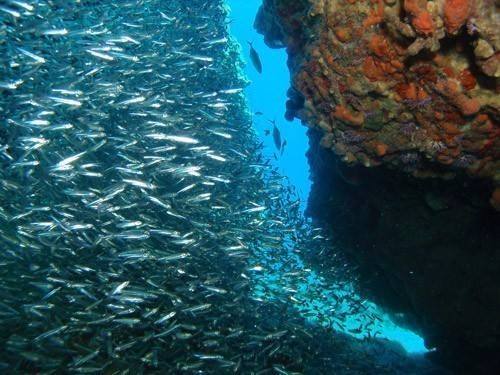(单词翻译:单击)
听力文本
This is Scientific American — 60-Second Science. I'm Steve Mirsky.
"So here's the first of the alewives, all silvery, they're all about the same size, you can't tell the boys from the girls. These will be the first."
Stephen Gephard, fisheries biologist with the Connecticut Department of Energy and Environmental Protection.
Gephard brought 400 alewives down from the Nutmeg state to be released into the Bronx River on the grounds of the Bronx Zoo on April 20th. The Bronx River was once so polluted that it was called an open sewer. But it's been cleaned up to the point where it can now once again support these fish, which were common here in the 19th century.
"Alewives are herring, they're kind of like a miniature shad." John Waldman is an aquatic conservation biologist at Queens College, who was on hand for the release.
"They're born in fresh water, they rear for the first year in freshwater then go to sea, spend a few years growing larger and then return to the river they were born in, much like salmon or sturgeon or shad. It's called an anadromous life history. And this river appears to have a small relic run that never really expanded because it was limited by the habitat."

"And now there's a fish ladder on the first dam and these fish that are being stocked today, 400 alewives...and the idea here is that if they spawn in this section, the young will kind of imprint on this area, run downstream and then return when they're old to spawn several years from now and want to go over the fish ladder."
"In the meantime, several fish have used the fish ladder on their own this week that were from wild fish that were existing as a little relic stock, I believe, in this section of the river, so between the two I think the future looks very promising to have a much larger run."
"The water here behind the Bronx Zoo is just perfect for alewife spawning, it's very slow moving, it's just what they like. And there's a series of dams above this first dam that are probably going to have fish ladders in the future, too. And if we get them all online working, this little river that flows through the heart of the Bronx could become a major alewife producer, which is kind of fun in its own right, to have such an urban location producing these wild fish, but it also is a great tie to the ocean."
"Alewives and other bait fish really drive the marine food chain, and this is a contribution to our greater coastal waters. So I'm very excited by the prospects of this restoration."
Gephard: "Alright, we gotta get 'em in the water."
For the Scientific American — 60-Second Science Science. I'm Steve Mirsky.
参考译文
这里是科学美国人——60秒科学。我是史蒂夫·米尔斯基。
“这是第一批灰西鲱,它们全身银色,体型也差不多,无法分辨公母。这将是第一批。”
斯蒂芬·格帕德是康涅狄格州能源与环境保护局的渔业生物学家。
4月20日,格帕德从“肉豆蔻州”(即康涅狄格州)带来了400条灰西鲱,在布朗克斯动物园把它们放生到布朗克斯河。布朗克斯河因曾经污染严重,而被称为“露天下水道”。不过这条河已被清理干净,现在足以再次供养这些鱼,19世纪时这些鱼在这里很常见。
“灰西鲱是鲱鱼的一种,有点像微型美洲河鲱。”约翰·瓦尔德曼是皇后学院的一名水生保护生物学家。他正准备放生。
“灰西鲱出生在淡水中,第一年在淡水中生活,然后游到大海长大,几年以后再回到它们出生的河流,这很像鲑鱼、鲟鱼或美洲河鲱。这种行为被称为溯河产卵生活史。这条河中似乎有一个小型的古老洄游鱼群,因为被环境所限,所以这一鱼群从未壮大。”
“现在,第一个大坝上有一个鱼梯,它拦住了今天被放生的400条灰西鲱,这里的想法是:如果它们在此地产卵,那小鱼会将这个地方印记在心里,小鱼会顺流而下,几年以后当这些小鱼长大以后要产卵时,会回到鱼梯这里来。”
“与此同时,本周已经有一些野生鱼自发使用了鱼梯,我相信,这些野生鱼是生活在河流这一河段的小型古生物。在这两种情况中,未来出现更大规模地洄游鱼群是有希望的。”
“布朗克斯动物园后面的水域是灰西鲱的最佳产卵地,这里水流缓慢,正是灰西鲱喜欢的产卵地。在第一个大坝之上还有很多水坝,将来很可能会设置鱼梯。如果我们让所有鱼梯一起作用,那这条流经布朗克斯中心的小河可能会成为灰西鲱的主要产地,城市区域会产生这些野生鱼,这本身就很有趣,不过这条河也是连接海洋的重要纽带。”
“灰西鲱和其它钓饵鱼的确推动了海洋食物链,而这是对更广阔的沿海水域的贡献。所以重建的前景让我感到非常激动。”
格帕德说:“好了,我们该把这些鱼放生到水里去了。”
谢谢大家收听科学美国人——60秒科学。我是史蒂夫·米尔斯基。
译文为可可英语翻译,未经授权请勿转载!
重点讲解
重点讲解:
1. clean up 清理,清除(污染物);
例句:Under pressure from the public, many regional governments cleaned up their beaches.
迫于公众压力,许多地区政府对各自海滩进行了清理。
2. once again 又一次;再次;
例句:Facts once again give the lie to the fallacy.
事实再一次揭穿了这一谎言。
3. on hand 在手头;在近处;现有;
例句:The Bridal Department will have experts on hand to give you all the help and advice you need.
婚礼用品部会有现成的专家为您提供所需的一切帮助和建议。
4. imprint on 印记;铭刻;
例句:He tried to imprint the number on his memory.
他试图把那个号码牢牢记住


